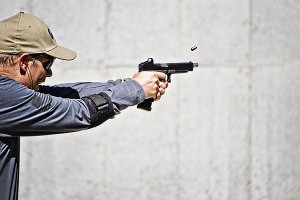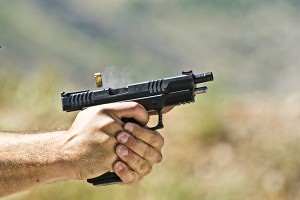By George Harris
Much has been written about precision shooting in the world of combat skill development and pistol shooting in general. Perspectives and definitions of how and why we hit the intended target vary so greatly that two people involved in a heated discussion regarding precision shooting may be very parallel in their thinking, but they don’t recognize it. In this article, I will talk about how and why our views concerning this subject work. Ultimately, the goal is to bring us all a little closer in defining this controversial subject and understanding what we need to see in order to deliver a successful shot.
All of my training methods stem from simplicity in firearms training. I like to cut through all of the fluff, and present concepts that make sense and are easily reproducible by the average shooter. Most of us subscribe to the age old premise that most likely originated with the invention of firearms in that the objective of shooting is hitting your target.
Let’s start by discussing the two absolutes of hitting a target. They are muzzle management and trigger finger discipline. Since the bullet exits the muzzle on the way to the target, it seems likely that from zero to fifty yards (plus or minus), if the muzzle is pointed at the target when the bullet exits, then we will have ourselves a hit where we want it. Trigger finger discipline refers to how we release the bullet toward the target. If you stabilize the muzzle of the pistol on the target and operate the trigger without disturbing that stability, you will experience success. Make sense? My students think so!
Precision shooting is a total mystery to some simply because they are confused about what they must see to consistently hit the target. Sight alignment and sight picture are two regularly used terms in the precision shooting world, but they aren’t always fully understood. Sight alignment is nothing more than the front and rear sight as viewed by the eye. Perfect sight alignment is the front sight vertically and horizontally centered in the rear sight notch. Sight picture is the target, front sight and rear sight as viewed by the eye. Perfect sight picture is the front sight centered vertically and horizontally in the rear sight notch superimposed on the desired point of impact of the target.
In studying human vision, we find that the eye can clearly focus on a single plane, plus or minus an inch or two. Everything else ranges from a little to a lot out of focus. Relate this to a camera lens. The camera has clarity at its primary point of interest and everything closer or further away is less than perfectly clear. A little known fact is that the eye can pick the center of any object, regardless of its shape. It can do this without having total visual clarity of the object and can be accurate down to one minute of angle (a half inch circle at fifty yards).
 Now, let’s take a closer look at how and why precision shooting works. The muzzle of the pistol must be square with the target to hit the target. Think perpendicular with a very slight upward angle to account for the effects of gravity on the bullet, and horizontally centered. We use our sights as a guide to position the muzzle on the target. The more precisely we align our sights, the closer the muzzle is to square with the face of the target, and the more likely we will hit our desired point of impact, assuming that the pistol is already zeroed. The clear focus on the front sight as viewed through the slightly out of focus rear sight allows us the best chance to position the muzzle square to the target. The target should be out of focus, but its shape should be apparent. As stated above, the eye will automatically find the center of any object.
Now, let’s take a closer look at how and why precision shooting works. The muzzle of the pistol must be square with the target to hit the target. Think perpendicular with a very slight upward angle to account for the effects of gravity on the bullet, and horizontally centered. We use our sights as a guide to position the muzzle on the target. The more precisely we align our sights, the closer the muzzle is to square with the face of the target, and the more likely we will hit our desired point of impact, assuming that the pistol is already zeroed. The clear focus on the front sight as viewed through the slightly out of focus rear sight allows us the best chance to position the muzzle square to the target. The target should be out of focus, but its shape should be apparent. As stated above, the eye will automatically find the center of any object.
What this boils down to is that precision sight alignment will square the muzzle (where the bullet exits the gun) on the center of the target, which our eye automatically finds, for a hit in the desired location.
Bull’s-eye shooters that shoot the blank side of their target and shoot better groups than when they are shooting the target side prove the concept that the eye will naturally find the center of an object consistently. By keeping the eye focus on the sights through the release of the shot, the muzzle remains square with the target, and a consistent impact point is hit again and again.
A simple and extremely effective sight picture that we developed for the aged-eye shooters (those in bi-focals and tri-focals) has become the standard sight picture for all of our students who aren’t happy with their present method of hitting the target where they want to. We recommend a dot on the front sight and the widest notch available for the type of rear sight to be used. This allows us to use the eye’s natural ability to center round objects in square openings with incredible precision. We zero the pistol for the strike of the round to hit whatever we put the front sight dot on, just as we would a red dot sight system. The regimen is to center the dot in the rear sight notch and float the dot on the target. With a smooth trigger press to release the shot, the thrill of a center hit is felt again and again.
EDITOR’S NOTE: The views and opinions expressed in this article are those of the author and do not necessarily reflect the official position of Action Target as a company.
About George Harris
George Harris has spent his entire adult life working in the world of firearms. For over 30 years he has been a successful and motivational educator and trainer in all aspects of small arms. His simplistic approach to firearms training has an unarguable track record in extracting performance from his students of marksmanship, tactics, and maintenance.
As a business developer in the firearms field, George co-founded the world renowned SIG Sauer Academy and led it to become a profit center before retiring after twenty-one years of service.
George has the enviable record of leading industry test programs for multiple government and military agencies achieving successful results and contracts for firearms 100% of the time.
Many of his innovations and ideas in firearms design features have evolved to production firearms improving function, ergonomics, and aesthetics.
George has served as the subject matter expert involving firearms and related matters on television, radio, and in legal proceedings.
Among his personal accomplishments, George earned the coveted U.S. Army Distinguished badges for both Service Pistol and Service Rifle. He also coached and was a firing team member of the World Champion U.S. Army Reserve International Combat Team before retiring with 40 years of continuous Military Service.






